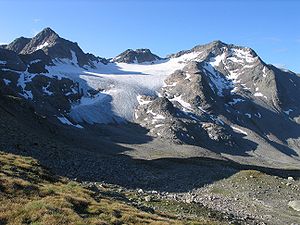Piz Sesvenna
| Piz Sesvenna | ||
|---|---|---|
|
Piz Sesvenna with the Sesvenna glacier |
||
| height | 3204 m above sea level M. | |
| location | Scuol , Switzerland | |
| Mountains | Sesvenna group | |
| Dominance | 21.4 km → Valvelspitze | |
| Notch height | 1055 m ↓ Ofenpass | |
| Coordinates | 826 621 / 177035 | |
|
|
||
The Piz Sesvenna ( ) is 3204 m above sea level. M. the highest mountain in the Sesvenna group in the Engadine . It is located just west of the Italian-Swiss border on Swiss territory, east of Scuol . To the north of the east ridge is the Sesvenna glacier .
You can reach the summit from the South Tyrolean Schlinig via the Sesvennahütte in the Schlinigtal . From here the path leads over the Sesvennascharte, the glacier and the east ridge to the highest point.
It is also possible to climb from Taufers through the Avignatal and from Val S-charl in Graubünden through Val Sesvenna to the glacier and over the east ridge to the summit.
The etymology of Sesvenna is unclear. It could be a Celtic field name, which is indicated by the typical Celtic suffix -enna ("locality"). In connection with the adjective * sisk ("dry", in Middle Irish sesc ), the mountain name would mean something like "dry locality", which would go well with the limestone rock with little surface water that is predominant in the Engadine. Sesvenna could also be Romanesque and derived from * sassvaina (" ore vein"), which refers to mining in the Val S-charl.
literature
- Hanspaul Menara : The most beautiful 3000m peaks in South Tyrol. 70 worthwhile alpine tours. Athesia, Bozen 2014, ISBN 978-88-8266-911-9
Individual evidence
- ↑ Summer tour to Piz Sesvenna 3204 m . Retrieved April 6, 2009
- ↑ Johannes Ortner: Sassvaina and Türggstroh . In: Experience the mountains - The magazine of the Alpine Association of South Tyrol . No. 3 , 2019, p. 40-41 .


